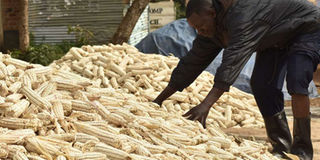We fail to plan yet expect to keep hunger at bay

A farmer in Kosele trading centre in Homa Bay County on June 9, 2017 sorts out maize cobs. Our country’s investment in agriculture must meet the Maputo target of at least 10 per cent of GDP. PHOTO | BARACK ODUOR | NATION MEDIA GROUP
What you need to know:
- There has been a lacklustre investment in food security, particularly the production of cereals such as maize.
- Kenya also sits among the bottom 20 countries in terms of undernourishment.
Kenya’s situation with food security has been deteriorating steadily particularly in the last five years and the current famine just sums up what has been coming and which could get worse unless we change course.
Our expenditure has been like that of a household that buys sufurias, gas cookers, micro-waves and refrigerators but forgets the most essential thing: Food.
Even as the country’s economy has grown from 4.6 per cent in 2012 to 5.8 per cent in 2016, aided largely by massive investment in roads, ports and rails, the quantity and quality of food Kenyans have consumed has nose-dived.
CEREALS
According to the Economic Survey 2017, the supply of calories, proteins and fats, which are critical for the well-being and productivity of a country’s population, has been erratic.
There has been a lacklustre investment in food security, particularly the production of cereals such as maize, wheat, rice, millet and sorghum - which are critical sources of calories.
Per Capita Daily Caloric Supply (the amount of food available for consumption, measured in kilocalories per capita per day) from cereals decreased by 3.4 per cent from 920,000 kilocalories in 2015 to 890,000 kilocalories in 2016.
PROTEINS
It was the same with Per Capita Caloric Supply from animal products, which decreased by 13.1 per cent from 313,000 kilocalories in 2015 to 272,000 kilocalories in 2016.
Per capita daily supply of proteins declined from 74 grams in 2012 to 64 grams in 2016, while that of fats decreased from 47 grams to 44 grams.
In its 2015 Statistical Pocketbook, the Food and Agriculture Organisation ranks Kenya among the bottom 20 countries in the world in terms of dietary energy supply (DES).
NUTRITION
DES is the food available for human consumption, and is expressed in kilocalories per person per day.
Kenya also sits among the bottom 20 countries in terms of undernourishment, or a level of food intake sufficient to meet dietary energy requirements, an indictment of Kenya’s food security.
In terms of undernourishment, Kenya ranked ahead of only 13 countries: Central Africa Republic, Côte d’Ivoire, Burkina Faso, Cameron, Rwanda, Malawi, Chad, Zimbabwe, Angola, Zambia, Madagascar, Uganda and Mozambique.
FOOD PRODUCTION
We have not done enough to encourage our farmers to engage in the production of food crops.
Production of cash-crops such as tea, coffee and flowers, on the other hand, do not seem to have suffered the same fate as food crops that are produced mainly for domestic consumption.
The Economic Survey found “notable growths in production of coffee and tea” even as agricultural sector was “dampened by considerable declines in production of food crops”.
SGR PROJECT
Specifically, production of maize declined from 42.5 million bags in 2015 to 37.1 million bags in 2016 while that of beans dropped from 8.5 million bags in 2015 to 8.1 million bags in 2016.
"Production of potatoes and drought-resistant crops such as sorghum and millet recorded significant declines,” read the survey in part.
This even as the country has pumped billions in expensive capital goods aimed at developing the country.
The Government got obsessed with the new standard gauge railway at the expense of the old strategic grain reserve.
AGRICULTURE
The fertiliser subsidy programme that targets the majority smallholder farmers has, instead, worked against them riddled as it is with corruption and inefficiency.
By and large, food producers have been left on their own, relying on same old small farms, old methods of production and old cultures of subdivision of land.
In the Maputo Declaration of 2003, signatory countries, including Kenya, agreed to, among other things; allocate at least 10 per cent of their budgets towards agricultural and rural development.
SMALL BUSINESSES
Yet currently, Kenya allocates about five per cent to agriculture.
To feed our people, we need to build on and enhance our traditional food production systems, revive interest in traditional food crops and develop integrated approaches to pest and production and to land and water management.
The country must continue to create a policy environment that allows small and medium sized enterprises and agro-industries to develop and flourish.
SUPPORT FARMERS
We must take practical steps to help increase local production, which should result in a reduction in food imports.
We cannot expect to feed our people when we neglect small holder farmers and leave them on their own.
Smallholder farmers need support to help them feed our families and compete in domestic, regional and international markets.
Above all, our country’s investment in agriculture must meet the Maputo target of at least 10 per cent of GDP.
The writer is Nasa presidential flag-bearer





